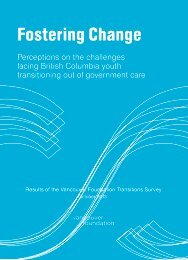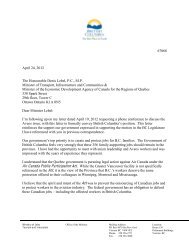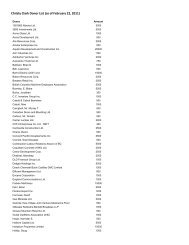from the ground up - The Tyee
from the ground up - The Tyee
from the ground up - The Tyee
You also want an ePaper? Increase the reach of your titles
YUMPU automatically turns print PDFs into web optimized ePapers that Google loves.
How Green School Buildings Help Children GrowStudents and teachers are more healthy and productive in sustainably-builtschools, research shows.By Katie HyslopArticle first published on February 9, 2011 by <strong>The</strong><strong>Tyee</strong>.ca.When <strong>the</strong> provincial government decided all newschool buildings must meet <strong>the</strong> LEED Gold standardin 2008, <strong>the</strong> motive was making B.C. <strong>the</strong>province with <strong>the</strong> first carbon-neutral governmentin Canada, with <strong>the</strong> added benefit of saving schooldistricts some energy costs.But new avenues of research into <strong>the</strong> effects of schoolbuildings on human health and productivity are producingevidence that <strong>the</strong> government’s move towardsgreener schools could be producing healthier, moreproductive and more environmentally aware students.A tale of a green Dickens<strong>The</strong> new Charles Dickens Elementary School was <strong>the</strong>first to achieve LEED Silver status in <strong>the</strong> VancouverSchool District when it opened in May 2008; however,<strong>the</strong> government wasn’t enforcing LEED Goldcertification <strong>the</strong>n, so <strong>the</strong> district had to use <strong>the</strong>ir ownfunds to reach <strong>the</strong>ir goal.*Some of <strong>the</strong> green features include an under<strong>ground</strong>rainwater cistern for non-potable water, geo<strong>the</strong>rmalrods that mine <strong>the</strong> earth’s heat to warm and cool <strong>the</strong>building, and electronic sensors that monitor <strong>the</strong>number of people in <strong>the</strong> room to determine how muchlight and heat is required.But while <strong>the</strong> custodial staff estimates significantenergy savings in comparison to <strong>the</strong> old buildings-- as much as 50 per cent less gas than previouslyrequired -- <strong>the</strong>re is little more than anecdotal evidence<strong>the</strong> building is producing healthier, more productivestudents and teachers.“I think <strong>the</strong> air quality is definitely different, I noticedthat right away <strong>from</strong> all <strong>the</strong> buildings that I’ve workedin,” says principal Kathy O’Sullivan.“And we do have some sickness, colds and <strong>the</strong> occasionalflu, which is during certain seasons, but I don’tsee a high absenteeism due to illness, so I think that’sa positive thing. I do see less dust and dirt.”Researchers in Canada and <strong>the</strong> U.S. want to turnanecdotes into hard facts by monitoring <strong>the</strong> affects ofnatural light, air quality, and acoustics on children’sability to learn, and as a result are discovering manyrequirements of sustainable structures are meeting<strong>the</strong> educational and health needs of children far betterthan traditional buildings can.Let <strong>the</strong>re be (natural) lightWhen Dickens was under construction, <strong>the</strong> Ministryof Education required at least 10 per cent of classroomwalls to be windows. But <strong>the</strong> designers at Stan-55








